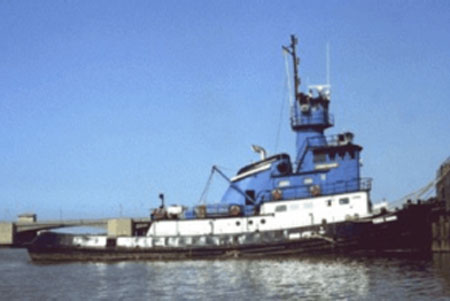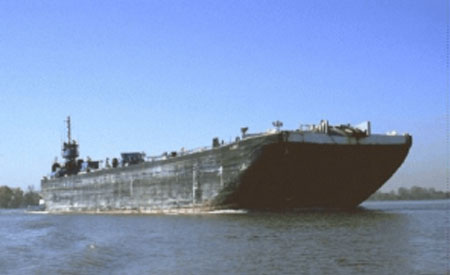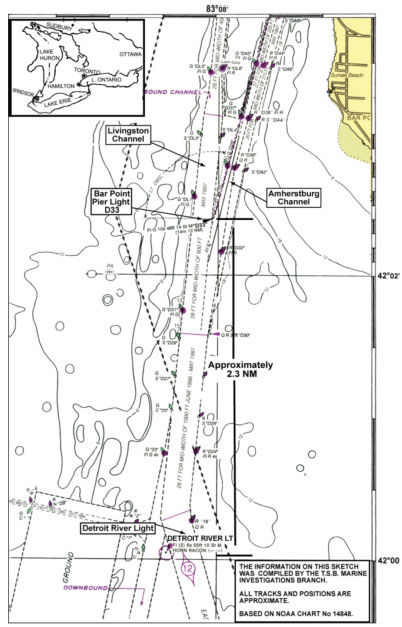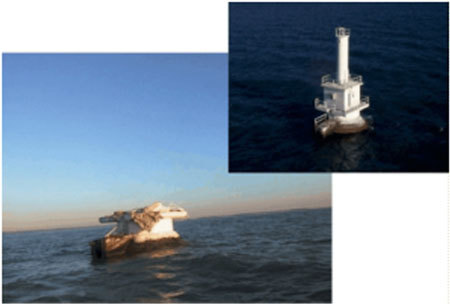Striking
by tug and barge Karen Andrie and A-397
off Bar Point Pier light D33, in the Lower Detroit River, Ontario
The Transportation Safety Board of Canada (TSB) investigated this occurrence for the purpose of advancing transportation safety. It is not the function of the Board to assign fault or determine civil or criminal liability. This report is not created for use in the context of legal, disciplinary or other proceedings. See Ownership and use of content. Masculine pronouns and position titles may be used to signify all genders to comply with the Canadian Transportation Accident Investigation and Safety Board Act (S.C. 1989, c. 3).
Summary
Early in the morning of 11 September 2004, while upbound in Canadian waters in the lower Detroit River, the barge A-397, pushed by the tug Karen Andrie, struck and knocked down Bar Point Pier Light D33. The barge was holed but remained afloat.
Ce rapport est également disponible en français
Factual information
Particulars of the vessels
| Name | Karen Andrie | A-397 |
|---|---|---|
| Official number | 297527 | 290177 |
| Port of registry | Cleveland, Ohio | Cleveland, Ohio |
| Flag | United States | United States |
| Type | Tug | Barge – bulk liquid cargo |
| Gross tonsFootnote 1 | 433 | 2928 |
| Length | 34.14 m | 82.32 m |
| Draught Forward | 3.81 m | 1.26 m |
| Draught Aft | 4.88 m | 1.67 m |
| Built | 1965 | 1962 |
| Propulsion | EMD 567 C diesel engines, 3600 HP, twin screw |
|
| Crew | 7 | N/A |
| Owners | Andrie Inc. Muskegon, Michigan |
Andrie Inc. Muskegon, Michigan |
Description of the tug and barge unit
Tug
The Karen Andrie is a conventional harbour and deep-sea towing tug of steel construction. It has an upper and lower wheelhouse for navigating. The upper wheelhouse can be reached internally through a stairwell from the lower wheelhouse. It has an open layout, with wide windows that provide an unobstructed view in all directions. It is large enough for at least two persons on bridge watch duty.
The Karen Andrie was fitted with an automatic identification system (AIS) unit, which permits a vessel to be tracked by another vessel and to be monitored by Vessel Traffic Services (VTS).
Barge
The barge A-397 was built as a tank barge with nine cargo tanks, certificated to carry high-flashpoint petroleum products such as asphalt. It has a raked bow designed for ease of movement in sea conditions (see Photo 2) and a notch at the stern for the bow of the Karen Andrie when it is pushing the barge. It also has two small pump rooms approximately 5 m by 3 m and 2.5 m high on the port and starboard sides of centre near the stern. The barge is equipped with navigation lights that meet regulatory requirements.
Location and description of navigation aid D33 (Bar Point Pier light D33)
Bar Point Pier Light D33 is located 2.35 nautical miles north of Detroit River Light at the southern junction of the Livingston and Amherstburg Channels (see Figure 1). Livingston Channel, north of Bar Point Light, is typically allocated to downbound (southbound) vessel traffic; Amherstburg Channel is typically allocated to upbound (northbound) traffic by Marine Communications and Traffic Services (MCTS Sarnia or Sarnia Traffic).
The light tower is 14 m high, with a light fixed atop a concrete and steel structure. The base of the light tower houses an equipment/service maintenance room and has its own small service dock. The light characteristic is a flashing green of 0.3 seconds and 9.7 seconds eclipse with a nominal range of 13 nautical miles. It is also a sector light, being visible from 191°C True (T) through west and north to 90°C T.
History of the voyage
On 10 September 2004 at 2136 eastern daylight timeFootnote 2, in clear visibility and light airs, the ballasted barge A-397, being pushed by the tug Karen Andrie, departed from Cleveland, Ohio. The master remained on the bridge until 0015 when the tow passed the harbour piers. The first and second mates worked alternate watch periods of six hours on, six hours off. At that time, it was the first mate's watch. The tow was bound for the Rouge River near Detroit, Michigan. On September 11 at 0305, the tow passed abeam of Pelee Island in the southwestern portion of Lake Erie. At 0500, on approaching Detroit River Light, the tow was making a speed of approximately 10 knots. The vessel was participating in the local VTS Zone.
At 0515, the master woke and arrived in the upper wheelhouse at 0530 to briefly discuss company business and then went below.
At 0540, the tow passed abeam of Detroit River Light at the calling-in point (CIP) and altered course a few minutes later, steering on automatic on a course of 006°C Gyro (G). At this time, the nearest vessel was the push-tow Kurt R. Luedtke and barge, which was upbound in the West Outer Channel, which converges with the East Outer Channel. It was approximately one nautical mile astern of the Karen Andrie and making good a speed of approximately six knots.
At 0545, the master ordered the second mate, who was just coming on watch, to prepare documentation for the loading port, then proceeded to the upper wheelhouse. After discussing traffic and ship's business for five minutes, the master assigned the first mate to prepare vessel documentation, notifications, and paperwork (for the arrival port loading operations) at the workstation in the lower wheelhouse. The master felt comfortable being in the wheelhouse alone. Bar Point Pier Light D33 was now approximately 1.5 nautical miles away.
There is an electronic chart system (ECS) unit attached to the port deckhead in the upper wheelhouse. The master switched the screen display lighting of the ECS monitor to the ON position for a brief "look about" using the brightness and contrast control knobs located on the screen. He switched it to OFF because he felt that the brilliance was too high even with the nighttime screen presentation feature activated. This software feature highlights navigation aids and reduces the ambient light of geographic features.
At range scales of mile and under, the upper wheelhouse radar would intermittently lose its picture. Despite having been serviced on August 9, this was an occasional, but recurring, problem. The master began switching range scales on the radar in an attempt to duplicate and see the problem.
Between 0553 and 0554, the master looked out of the wheelhouse windows ahead and astern and was satisfied that the tow was within the channel limits. He then looked at the chart. Based on what he could see on the radar, the tow was within the channel limits, maintaining a heading of between 005°C G and 006°C G, that is, heading directly for Bar Point Pier Light D33. The master called down to the first mate and asked him to print and bring the tug's port schedule to the upper wheelhouse. The first mate brought the document, placed it on the chart table, and went back below. The master continued his attempts to recreate the ¾-mile range radar problem.
At 0556, in darkness, clear visibility, and light airs, the forward end of the barge struck and knocked down Bar Point Pier Light D33 (see Photo 3). The accident occurred in Canadian waters.
The push-tow backed off the damaged light structure base almost immediately and remained on location. The crew of the tug examined the barge for damage and found the forepeak tank holed and flooded. No other tanks appeared to have been damaged. Within a few minutes of the striking, the master reported the occurrence by cellular telephone to the company and the United States Coast Guard, who instructed the unit to return to Toledo, Ohio, for repairs.
Meanwhile, Sarnia Traffic had noticed on its AIS display that the push-tow had remained at the location of Bar Point Pier Light D33 for some 20 to 25 minutes. After that time, the master began a starboard turning manoeuvre, which briefly placed the tow in the upbound channel. Sarnia Traffic contacted the Karen Andrie by very high frequency (VHF) radio. At the request of the master, further communication was carried out using cellular telephones, and he called Sarnia Traffic and apprised them of the striking and of his intention to turn the tow around and proceed back to Toledo.
The Karen Andrie did not broadcast its manoeuvring intention by VHF radio nor did it communicate with the upbound Kurt R. Luedtke. The Kurt R. Luedtke and barge, which was now entering the Amherstburg Channel, altered course slightly to starboard to keep clear in the shallow draught section of the channel. The master of the Kurt R. Luedtke realized that the light was out of action when his vessel passed the turning Karen Andrie and barge A-397 and he saw the wreck of the light. Sarnia Traffic was not notified of the striking until some 20 to 25 minutes after the fact, after communication with the Karen Andrie had been established.
Damage to barge A-397
There was extensive plating and frame damage to the forepeak tank and a 6 m by 9 m hole at the rake of the bow. The collision bulkhead remained intact but weakened.
Damage to Bar Point Pier light D33
The light tower and the service/control room were destroyed. The concrete and steel base suffered some damage; however, an engineering survey found the base to be intact.
Bridge crewing
The company operates its vessels with one master and two mates. The company's standard operating procedures (SOPs) require the presence in the wheelhouse of one licensed person capable of piloting when a vessel is navigating the confined waters of rivers and channels within the VTS zones. Because the second mate did not have a pilot's endorsement on his certificate, the company SOPs required the master to be present in those navigating circumstances. The first mate had a pilot's endorsement on his certificate and was therefore alone in the wheelhouse for the majority of his watch.
The Crewing Regulations, made pursuant to the Canada Shipping Act and applicable to Canadian vessels of 200 in gross tonnage or more state:
- 38. Every ship that is not securely anchored in port or securely moored to shore shall ensure that a deck watch is maintained in accordance with Parts 2, 3 and 3-1 of section A-VIII/2 of the STCW CodeFootnote 3.
These sections provide, among other things, that a "proper lookout shall be maintained at all times … the lookout must be able to give full attention to the keeping of a proper lookout" and "the officer in charge of the navigational watch may be the sole lookout in "daylight" under specified conditions."
Composition of the Deck Watch
- 40.(1) The minimum deck watch required by this section shall be supplemented as required by the ordinary practice of seamen,
- 40.(2)(b) Subject to subsections (3) and (4), an additional person who, where the ship is 200 tons or more, holds an efficient deckhand certificate, an able seaman certificate or a bridge watchman certificate… .
Under Canadian regulations, the Karen Andrie was required to have two people in the wheelhouse.
In the United States, under Section 46 of the Code of Federal Regulations (CFR), for any uninspected vessel over 200 gross tons, one qualified person is all that is needed, except when the voyage exceeds 12 hours. The "Captain of the Port" of any larger American port Marine Safety Office (United States Coast Guard) may, at his/her discretion, require two people on the bridge at all times when traversing their respective sectors. The Captain of the Port of Detroit (the area encompasses the occurrence location) did not require two people on the bridge. If a tug has an upper and lower wheelhouse, and two watchkeepers are required, American regulations allow one watchkeeper in each wheelhouse. The time required to complete the voyage of the Karen Andrie and barge A-397 was less than 12 hours.
Under American regulations, the Karen Andrie was not required to have two people in the wheelhouse.
Safety management
Although the company does not have a formal safety management system (SMS), it has mechanisms in place to identify safety issues and rectify them. These mechanisms are:
- daily vessel calls—Every morning, each vessel has a 15-minute window to call. Calls go to a dispatcher during the week and to a duty manager on weekends, with anything unusual reported to the Captain of the Port.
- weekly engineering calls
- monthly safety meetings
- emergency reporting—The company policy is "to notify as soon as possible of an emergency," but it does not specify how or whom to notify, or in what priority.
Electronic chart system and night display
In addition to a manual brilliance control on the monitor screen, the ECS software has a monitor screen brilliance feature with both day and night settings. On the night setting, objects and navigation channel edge markings appear light on a dark background, and glare is reduced to a minimum. However, in the absence of standards for ECS monitors,Footnote 4 the backlighting on newer LCD monitors (purchased off-the-shelf as a more economic alternative) may result in a residual glow that may be bright for certain operational conditions–even with the ECS on night setting.
Radar
There had been a problem with the upper wheelhouse radar unit of the Karen Andrie. The former master had noted it in the bridge logbook on 09 August 2004 and reported to the owners that it needed servicing. A service company technician came aboard to repair the radar on August 13. On September 10 at 0900, the current master called the repair company again about the recurring problem on the ¾-mile and below range scale settings. At the time of the TSB investigation, an attempt was made to duplicate the ¾-mile and below range scale problem, but the problem could not be duplicated. When the radar was tested, investigators found that, on each range scale setting and after proper tuning, the time-base trace revealed a clear picture with good discrimination.
Personnel qualifications and experience
The master holds a United States licence for Master of Steam or Motor Vessels of not more than 1600 gross registered tons, issued in 1982, renewed on 28 May 2002, and valid for five years. His licence was pilot-endorsed, allowing him to pilot throughout the areas of operation. He had worked for the vessel owners since 1977. The master has held command endorsements since 1984. He had not received any formal training on the ECS.
Analysis
One-person bridge operations
The composition of the watch on the bridge is crucial to safe navigation and environmental protection, and must be appropriate to the prevailing circumstances and conditions. When a vessel is approaching a major course alteration, good seamanship calls for the first officer to remain in the upper wheelhouse to assist the master. However, when the master arrived on the bridge, he took over the conduct of the vessel and sent the officer of the watch down to carry out non–navigation-related duties at a critical time in the vessel's transit.
During this accident, the master, alone on the bridge, was navigating a push-tow in confined waters when it struck and knocked down the fixed light.
Investigations into other marine accidents involving collisions and groundings of tug and barge operations have revealed that a cause or contributing factor has been the failure to maintain an adequate navigational watch. For example, the investigation into the collision between the pleasure craft Sunboy and the barge Texada B.C. being towed by the Jose Narvaez (TSB report M99W0133) indicated that, as a result of navigational practices on the tug, especially that of leaving the tug's wheelhouse unattended, the tug's crew was unaware of the pleasure craft at a critical time during the passage. The accident resulted in four fatalities and a fifth person, who was presumed drowned.
In 2002, when the tug Progress pushing the barge Pitts Carillon struck a fixed light (TSB report M02C0011), the first officer, while operating in restricted waters at night, was required to steer and navigate the vessel. To carry out navigation duties while steering, he had to briefly leave the helm unattended to perform another function. The combined tasks of steering while navigating made maintaining awareness of the vessel's position extremely difficult; as a result, the push-tow struck and knocked down the fixed light.
The practice on board this vessel, and on other company vessels, was that at least one certificated person be on the bridge. Over time, the master had safely completed many voyages in these waters while alone on the bridge, so he did not consider it necessary to assign an additional person to the bridge watch. As a result, when he became preoccupied with trying to reproduce a previously reported problem with the radar display, he did not notice the dangerous situation that was developing.
With no one else on the bridge to assist in navigation, bridge resource management was not possible, and an opportunity to bring the rapidly developing situation to the attention of the master was lost, leading to a single-point failure.
Electronic navigation
The use of off-the-shelf LCD monitors for ECS displays may result in a residual glow from the backlighting that, even in night setting, may interfere with night navigation. In this occurrence, despite using the ECS night viewing function and setting the monitor brilliance at minimum, the master felt that the ECS display was too bright and turned off the display monitor. This action resulted in the loss of real-time position monitoring on an electronic navigation chart, thereby removing a defence barrier for the master.
Cellular telephones and very high frequency communications
It is beneficial to have vessels maintain a continuous listening watch on a common radiotelephone channel when operating in confined waters so that crews can become aware of situations developing in their vicinity and can take early, appropriate action. This occurrence was reported to a marine traffic regulator (Sarnia Traffic) indirectly by cellular telephone rather than by VHF radio from the occurrence vessel.
Within minutes of the striking, the master of the Karen Andrie informed company officials and the United States Coast Guard of the occurrence, but did not inform Sarnia Traffic until some 25 minutes later. Additionally, the Karen Andrie did not inform the nearest approaching tug Kurt R. Luedtke and barge immediately after the striking to warn them that Bar Point Pier Light D33 was now out of commission. In this instance, the master of the Kurt R. Luedtke was vigilant, and the unit was navigated with caution. However, delays in notifying the MCTS and the use of an inappropriate communication method precluded timely broadcast of critical safety information to traffic in the vicinity and could have placed other vessels at undue risk.
Conduct of watchkeeping
Bar Point Pier Light D33 is radar conspicuous and would have painted a good return echo on the radar screen while the tug and barge were traversing the short distance between Detroit River Light and Bar Point Pier Light D33. Standard radar watchkeeping requires some minimal level of attention to the discrimination of targets: it is necessary to have a look around on different scales. However, the unit was operating in good visibility in the vicinity of good fixed and floating navigation aids. Despite this, the master elected to duplicate the radar problem on the ¾-mile range at a critical time when the vessel was headed for the D33 light. As such, the progress of the unit was not monitored despite the availability of good visual cues, and a proper lookout was not maintained.
Company's approach to safety
In this instance, the company had a standard operating procedure for navigation. However, guidance was not provided for prioritizing communications in emergencies. Additionally, it did not have a policy regarding formal ECS training for navigating officers.
Damage assessment
After the crew's initial damage survey, the tow was moved into deeper water to proceed to Toledo. Without a comprehensive survey of the damaged barge by qualified inspectors or class surveyors, the condition of the weakened hull and the possibility of the barge sinking and blocking the navigable channel was not fully evaluated.
Findings
Findings as to causes and contributing factors
- At a critical juncture when the vessel was approaching a course alteration, the master was preoccupied with recreating a radar range scale problem and was unaware of the vessel's position. As a result, the barge A-397 struck and knocked down Bar Point Pier Light D33.
- As the vessel was operating with a one-person bridge watch, consistent with American domestic regulations, bridge resource management was not possible, and the opportunity to bring the rapidly developing situation to the attention of the master was lost, leading to a single-point failure.
Findings as to risk
- Not reporting the occurrence and the damage to the navigation aid to the Marine Communications and Traffic Services in a timely and appropriate manner delayed broadcast and deprived navigators of information critical to the safe operation of the vessel.
- Given that no comprehensive inspection survey of the barge was carried out, there was some risk to the tow's safety and to other shipping navigating in the vicinity.
- The use of off-the-shelf LCD monitors for electronic chart system displays may result in a residual glow from the backlighting that, even in night mode, may interfere with night navigation.
Other findings
- The Canadian and American crewing regulations are not in harmony and do not provide the same level of safety for vessels operating in each other's waters.
Safety action
Safety action taken
Since the occurrence, the following safety actions have been taken by the owners, Andrie Inc.:
- Captains and mates are required to attend a United States Coast Guard–approved bridge resource management course for towing vessels.
- Under a new policy, pilot house electronics are not to be turned off while the vessel is operating.
- All monitors are now capable of being dimmed or have a filter available to reduce the light produced. Before the incident, the electronic chart system monitors could not be dimmed sufficiently during nighttime operations.
- The company internal investigative report was shared with its captains in the form of a directive on the lessons learned and then distributed among crew members. Proper procedures were reviewed during vessel safety meetings.
- The company is reviewing standard operating procedures for watch changes and may implement new guidelines for watch changes in or near confined waters.
- The radar in the upper wheelhouse has been updated with a new and independent global positioning system that is tied into the ECPINS (electronic chart precise integrated navigation system), eradicating radar unit problems.
- The company maintains a form that outlines when a vessel is to notify the Environmental and Safety Coordinator and a form with a notification checklist for qualified individuals.
This report concludes the Transportation Safety Board's investigation into this occurrence. Consequently, the Board authorized the release of this report on .



